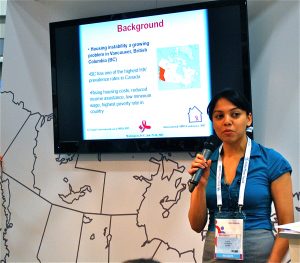Surita Parashar helps facilitate “The way I see it,” a community based research project that uses Photovoice methodology to examine the impact of housing on health as seen through the eyes of people living with HIV and AIDS in Vancouver. The project is led by a team of Community Researchers – Randy, Rob, Valerie, Lora, Lynda, Dan, Mel and Jenny – all of whom are living with HIV and passionate about housing research and advocacy. This work is supported by Rosa and Lyanna at the Dr. Peter AIDS Foundation; Kim at McLaren Housing Society of BC; and Bob, Kate, Angela, Ali, Kevin, Chris, Cameron and Jay at the BC Centre for Excellence in HIV/AIDS (BC-CfE). This participatory action research project is the focus of Surita’s work at the BC-CfE, the subject of her PhD research at SFU’s Faculty of Health Sciences, and the centre of her universe.
What first piqued your interest in HIV research?
My interest in HIV research is actually just an interest in people. I have long been the person having loud conversations with strangers on buses and street corners. If you have enough conversations with strangers you will eventually find yourself thinking a lot about human rights.
In later years I discovered and cultivated my skills in talking about topics that make people uncomfortable while teaching sex education for the Vancouver Coastal Health Authority.
Human rights + sexual and reproductive health – it was inevitable that HIV research would find me. After doing some overseas work I returned to Vancouver to focus on issues that I had grown up observing but not fully understanding, particularly about the way disease/disability/destitution are concentrated in particular populations and neighbourhoods.
The AIDS movement started out very grassroots, which means my work always keeps me in the company of inspiring people who can share their lived experience. So it really is people’s stories that piqued my interest and has kept me interested in this work all these years.
How is the community involved in your research?
The community is so involved with this research that I can hardly take credit for it, and I feel funny doing this interview! From its conceptualization we have endeavoured to make “The way I see it” a community-driven initiative.
The need to do this work was identified in conversations with the folks at the Maximally Assisted Therapy (MAT) program at the Downtown Community Health Centre. Researchers from the BC Centre for Excellence in HIV/AIDS (BC-CfE) had been working on a study that involved MAT clients and it was recognized that the definition of housing used in this study did not capture the nuances and diversity in people’s experiences.
We recognized a need to involve affected communities in developing a comprehensive, contextualized understanding of what it means to be unstably housed in Vancouver, and what impact this has on health. The BC-CfE, in collaboration with the Dr. Peter AIDS
Foundation, Positive Women’s Network and McLaren Housing recruited 9 incredible people living with HIV and passionate about housing research and advocacy to take on this project.
Since then it has been the team of Community Researchers – Randy, Rob, Valerie, Lora, Lynda, Dan, Mel and Jenny – who have been leading this work.
How is your research applicable in the “real world”?
Every aspect of this work is grounded in the “real world” – from the issues we’re dealing with, to the methods we are using, to the experiences on which this project is based.
“The way I see it” is, at the end of the day, about having a place to call home, a place to rest your head. That’s a ‘real world’ issue that people can easily relate to, even if their experiences are vastly different from those of the Community Researchers. We chose Photovoice as a method to help make these issues more real to the wider community – it is hard to fathom the conditions people live in until you are confronted with visual evidence. And finally, it is the experiences of the Community Researchers that guide and inform this work.
If you had unlimited funds, what area of research would you invest in?
If I had unlimited funds I would be tempted to hand it over to organizations and individuals who provide harm reduction, mental health services, social support, safe living space and healthy food to anybody and everybody who needs it. That’s not research, but it can be if you build in comprehensive monitoring and evaluation of the services these organizations provide. Specifically, investing in partnerships between research institutions and service providers can help ensure these wonderful organizations are able to demonstrate the crucial need for their programs to funders, policymakers and the general public.
If you were able to choose, what is the natural talent you’d like to be gifted with and why?
I wish I could stop myself from Hulking Out. To “Hulk Out” in this sense is to completely lose your ability to articulate your opinions and provide supporting evidence when faced with people with opposing viewpoints.
I am very lucky to live and work alongside people who share my beliefs about the important stuff – politics, the environment, how people should be treated. Once in a blue moon I find myself in a conversation with someone who believes something different – usually the person sitting beside me on a long haul flight. They try to convert me; I try to show them the light. It’s all relatively peaceful until I inevitably Hulk Out. I see brilliant people who also hold their work close to their hearts who, placed in the same situation, are able to stay calm and matter-of-factly provide supporting evidence. Evidence engages and teaches people, Hulking Out does not.


